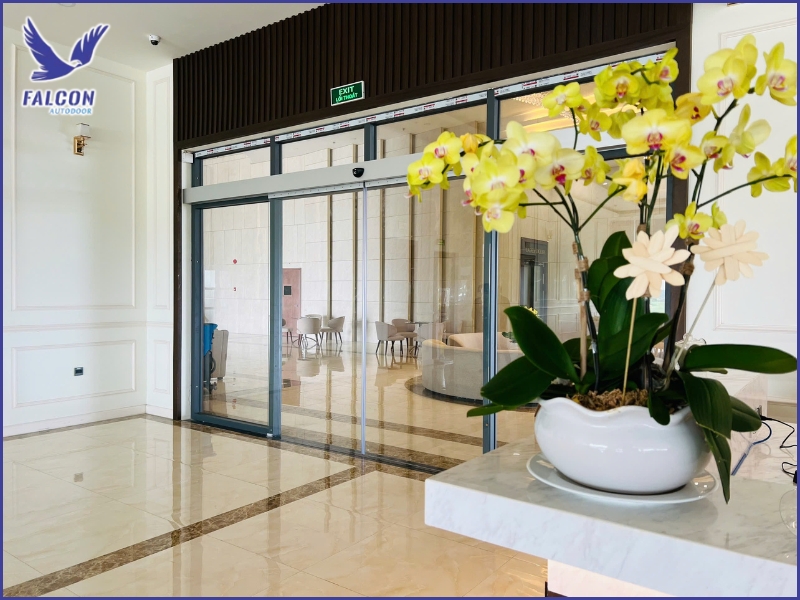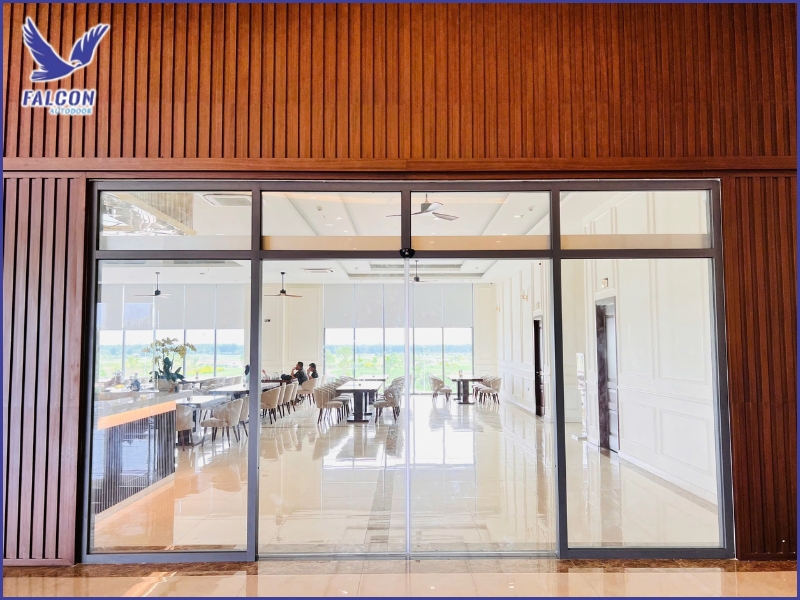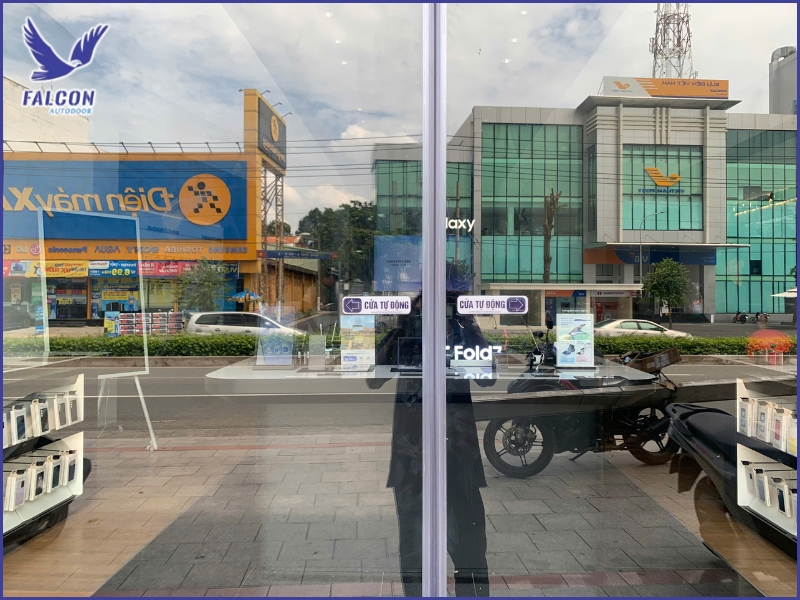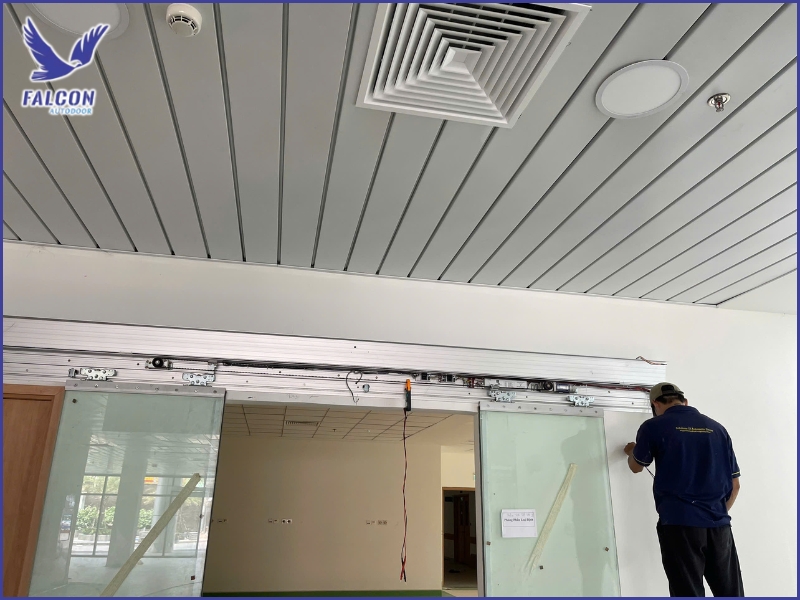Solutions to prevent hand trapping and collisions in automatic doors
In modern buildings, automatic doors not only provide comfort but also must ensure maximum user safety. This article from Thuy Linh Long introduces effective anti-pinch and collision-prevention solutions that help doors operate smoothly, intelligently, and safely in all environments.
1. Why automatic doors need anti-pinch and anti-collision features
Automatic doors operate using motors and sensors; without built-in safety mechanisms, users are at risk during opening and closing cycles. Integrating anti-pinch and collision-prevention functions protects users while maintaining the durability of the entire system.
1.1 Ensuring user safety
Automatic doors move with significant force and speed, so without a stop or reverse mechanism, users especially children and the elderly can get their hands caught or collide with the moving leaf. Safety sensors detect obstacles instantly, stopping or reopening the door to prevent accidents.
1.2 Reducing damage to motors and sensors
Frequent impacts or collisions generate reverse forces that can shorten motor lifespan and cause sensor misalignment. Anti-pinch mechanisms automatically adjust closing and opening forces, keeping operations stable and avoiding motor overload.
1.3 Meeting public safety standards
According to installation regulations, automatic doors in hospitals, malls, and office buildings must include anti-pinch and anti-collision features compliant with EN16005 or CE standards. This ensures safety for users and legal compliance for facility managers.

2. How anti-pinch and collision-prevention systems work
These safety systems detect obstacles and respond instantly to avoid injury and mechanical damage. With advanced sensors and a centralized controller, the door can stop, reverse, or slow down when it senses interference in its motion path.
2.1 Obstacle detection sensors
Infrared or microwave sensors installed on both sides of the door detect motion or objects in the active zone. When a person or object is detected, a signal is sent to the controller to pause or keep the door open.
2.2 Reversal mechanism on impact
When an obstacle is detected during closing, the motor automatically reverses direction to reopen the door. This function is particularly important in busy public areas, minimizing collision and pinching risks.
2.3 Speed control system
Modern automatic doors are programmed to slow down near the end of their closing cycle. This gentle deceleration prevents harsh impacts and ensures user safety near the entrance area.
2.4 Multi-zone intelligent sensors
High-end doors feature multi-zone sensors that distinguish between movement direction and object type. They react only to relevant motion while ignoring light or airflow interference, improving detection accuracy and energy efficiency.

3. Popular safety solutions for automatic doors
To minimize pinching and collision risks, manufacturers have integrated advanced safety technologies into modern automatic doors. Each solution enhances sensitivity, reaction time, and overall user protection in various operating environments.
3.1 Multi-point safety sensors
These sensors scan the entire door path, detecting obstacles at both low and high levels. When a person or object enters the detection zone, the door immediately stops or reopens, preventing potential accidents.
3.2 Shock-absorbing rubber gaskets
Thick rubber seals installed along the door edge absorb impact when the door closes. This design softens contact, minimizes injury, and ensures a quieter, smoother closing motion.
3.3 Automatic reverse mechanism
When the door encounters an obstacle, the motor automatically reverses direction to reopen. This feature is crucial for high-traffic public spaces such as hospitals, supermarkets, or airports, where movement is constant and unpredictable.
3.4 Slow-closing programming
Setting a gradual closing speed at the end of the door’s motion reduces impact force and wear. This approach improves motor longevity while providing a safer, more comfortable user experience.
3.5 Mechanical or electronic braking system
Premium door models use mechanical or electronic brakes to control motion speed and force. When sensors detect a potential collision, the brake gently stops the door, preventing sudden halts that could damage the motor or drive components.

4. Installation and maintenance considerations for door safety systems
An automatic door’s safety features only work effectively when installed and maintained correctly. Most malfunctions are caused not by poor components but by incorrect installation or neglected calibration that leads to inaccurate sensor response.
4.1 Use compatible and genuine components
Sensors, motors, and control boards should come from the same manufacturer to ensure signal compatibility. Mixing components from different brands may cause communication errors or delayed obstacle detection.
4.2 Accurate sensor placement
Sensors must be positioned at the correct height and angle to detect both children and low objects. Avoid areas with strong light, drafts, or reflective surfaces, which can cause false triggers and malfunction.
4.3 Routine cleaning and maintenance
Dust accumulation is a major cause of unstable sensor performance. Clean the sensor lenses, sliding tracks, and gaskets every 2-3 months, and check door speed and responsiveness to maintain smooth, safe operation.
4.4 Contact technicians for abnormal operation
If the door moves slowly, makes noise, or stops suddenly, do not attempt self-repair. Call a qualified technician for inspection, as improper handling can damage sensors or control boards, affecting the entire system.

Anti-pinch and anti-collision technologies not only enhance safety but also reflect the professionalism of modern architecture. For fully certified international-standard automatic door systems, contact Thuy Linh Long for consultation and installation of genuine Falcon doors durable, refined, and absolutely safe for every space.
THUY LINH LONG SERVICES TRADING COMPANY LIMITED
DISTRIBUTOR
Address: 243D Vuon Lai Street, Phu Tho Hoa Ward, Tan Phu District,
Ho Chi Minh City, Vietnam.
Tel: +84 28 22497999
E-mail: cuatudong24h@gmail.com
SUPPLIER
KUM YANG MATERIALS CO.,LTD
Address: 124-60, Myeongdong-ro, Hallim-myeon,
Gimhae-si, Gyeongsangnam-do, 50851, Korea.
Tel: 82-55-345-8380










